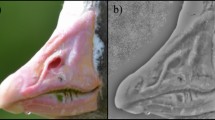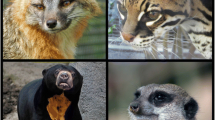Abstract
Inter-specific variation in the occurrence of individual recognition (IR) has mostly been examined in species that differ with respect to two critical conditions necessary for such ability: presence of complex social behaviours and sender’s distinctiveness. However, variation in IR when species share such conditions is lesser known. We tested for IR in the paper wasp Polistes versicolor and compared the results with published information on IR in Polistes fuscatus. Both species have a flexible nest-founding behaviour and form dominance hierarchies. Additionally, both have individually distinctive facial patterns. P. versicolor faces are highly variable, and they do not appear to be associated with individual quality, consistent with the role as cues in IR. However, the wasps did not discriminate between nestmates with familiar and unfamiliar faces. Besides, wasps did not discriminate between familiar and unfamiliar social partners. Familiar discrimination (discrimination of individuals based on prior social interactions) is considered the first stage toward IR; therefore, P. versicolor wasps, unlike P. fuscatus, lack the ability for IR. Our results suggest that the high variation in colour pattern may not be a good proxy for the occurrence of IR in paper wasps and that neutral variation may be an underestimated factor promoting phenotypic variability.
Significance statement
High inter-individual phenotypic variability in primitively eusocial paper wasps has sometimes been considered to be a result of selection for efficient individual identity signalling, especially because senders may benefit from being individually recognised. P. versicolor paper wasp females have highly variable inter-individual facial patterns. However, we demonstrated that they lack individual recognition. After excluding some potentially confounding hypothesis, we conclude that selection for efficient individual identity signalling is not the only factor promoting phenotypic variability in paper wasps and that at least in some species, neutral variation may play a role.



Similar content being viewed by others
References
Baracchi D, Petrocelli I, Cusseau G, Pizzocaro L, Teseo S, Turillazzi S (2013) Facial markings in the hover wasps: quality signals and familiar recognition cues in two species of Stenogastrinae. Anim Behav 85:203–212
Baracchi D, Turillazzi S, Chittka L (2016) Facial patterns in a tropical social wasp correlate with colony membership. Sci Nat 103:80
Barnard CJ, Burk T (1979) Dominance hierarchies and the evolution of “individual recognition”. J Theor Biol 81:65–73
Beecher MD (1989) Signaling systems for individual recognition—an information-theory approach. Anim Behav 38:248–261
Beletsky LD, Orians GH (1989) Familiar neighbors enhance breeding success in birds. P Natl Acad Sci USA 86:7933–7936
Bergman TJ, Sheehan MJ (2013) Social knowledge and signals in primates. Am J Primatol 75:683–694
Bergman TJ (2010) Experimental evidence for limited vocal recognition in a wild primate: implications for the social complexity hypothesis. P Roy Soc Lond B Bio Sci 277:3045–3053
Burns JG, Foucaud J, Mery F (2011) Costs of memory: lessons from ‘mini’brains. P Roy Soc Lond B Bio Sci Rspb 20102488
Cervo R, Cini A, Turillazzi S (2015) Visual recognition in social wasps. In: Laura A, Tricarico E (eds) Social recognition in invertebrates, Springer International Publishing, pp 125–145
Crowley PH, Provencher L, Sloane S, Dugatkin LA, Spohn B, Rogers L, Alfieri M (1996) Evolving cooperation: the role of individual recognition. Biosystems 37:49–66
Cure C, Aubin T, Mathevon N (2009) Acoustic convergence and divergence in two sympatric burrowing nocturnal seabirds. Biol J Linn Soc 96:115–134
Dale J, Lank DB, Reeve HK (2001) Signaling individual identity versus quality: a model and case studies with ruffs, queleas, and house finches. Am Nat 158:75–86
Dawkins MS, Guilford T (1991) The corruption of honest signalling. Anim Behav 41:865–873
De Souza AR, Martins LCB, Mourão-Júnior CA, Serrão JE, Lino-Neto J (2014b) Robust memories of individual identity in ant queens. J Insect Behav 27:251–256
De Souza AR, Júnior CAM, Nascimento FS, Lino-Neto J (2014a) Sexy faces in a male paper wasp. PloS One 9:e98172
De Souza AR, Prezoto F (2012a) Regulation of worker activity in the social wasp Polistes versicolor. Insect Soc 59:193–199
De Souza AR, Prezoto F (2012b) Aggressive interactions for a decentralized regulation of foraging activity in the social wasp Polistes versicolor. Insect Soc 59:463–467
De Souza AR, Ribeiro B, José N, Prezoto F (2012) Paint marking social wasps: an evaluation of behavioral effects and toxicity. Entomol Exp Appl 144:244–247
D'Ettorre P, Heinze J (2005) Individual recognition in ant queens. Curr Biol 15:2170–2174
Doorn GSV, Hengeveld GM, Weissing FJ (2003) The evolution of social dominance II: multi-player models. Behaviour 140:1333–1358
Downing HA, Jeanne RL (1985) Communication of status in the social wasp Polistes fuscatus (Hymenoptera: Vespidae). Z Tierpsychol 67:78–96
Dreier S, D’Ettorre P (2009) Social context predicts recognition systems in ant queens. J Evolution Biol 22:644–649
Dreier S, Van Zweden JS, D'Ettorre P (2007) Long-term memory of individual identity in ant queens. Biol Lett 3:459–462
Dukas R (1999) Costs of memory: ideas and predictions. J Theor Biol 197:41–50
Eickwort K (1969) Separation of the castes of Polistes exclamans and notes on its biology (Hym: Vespidae). Insect Soc 16:67–72
Enteman W (1904) Coloration in Polistes. University of Chicago, Chicago
Gherardi F, Aquiloni L, Tricarico E (2012) Revisiting social recognition systems in invertebrates. Anim Cogn 15:745–762
Gherardi F, Atema J (2005) Memory of social partners in hermit crab dominance. Ethology 111:271–285
Gibo DL (1978) The selective advantage of foundress associations in Polistes fuscatus (Hymenoptera, Vespidae): a field study of the effects of predation on productivity. Can Entomol 110:519–540
Gobbi N, Noll FB, Penna MA (2006) “Winter” aggregations, colony cycle, and seasonal phenotypic change in the paper wasp Polistes versicolor in subtropical Brazil. Naturwissenschaften 93:487–494
Gobbi N (1977) Ecologia de Polistes versicolor (Hymenoptera: Vespidae). Ph.D. Thesis. São Paulo University, SP, Brazil
Gronenberg W, Ash LE, Tibbetts EA (2007) Correlation between facial pattern recognition and brain composition in paper wasps. Brain Behav Evolut 71:1–14
Hölldobler B, Wilson EO (1990) The ants. Harvard University Press, Cambridge
Injaian A, Tibbetts EA (2014) Cognition across castes: individual recognition in worker Polistes fuscatus wasps. Anim Behav 87:91–96
Itô Y (1985) A comparison of frequency of intra-colony aggressive behaviours among five species of polistine wasps (Hymenoptera: Vespidae). Z Tierpsychol 68:152–167
Job DA, Boness DJ, Francis JM (1995) Individual variation in nursing vocalizations of Hawaiian monk seal pups, Monachus schauinlansi (Phocidae, Pinnepedia), and lack of maternal recognition. Can J Zool 73:975–983
Johnstone RA (1997) Recognition and the evolution of distinctive signatures: when does it pay to reveal identity? P Roy Soc Lond B Bio Sci 264:1547–1553
Lehmann L, Perrin N (2002) Altruism, dispersal, and phenotype-matching kin recognition. Am Nat 159:451–468
Medvin MB, Stoddard PK, Beecher MD (1992) Signals for parent-offspring recognition: a comparative analysis of the begging calls of cliff swallows and barn swallows. Anim Behav 45:841–850
Medvin MB, Beecher MD (1986) Parent-offspring recognition in the barn swallow (Hirundo rustica). Anim Behav 34:1627–1639
Oliveira SA, Castro MM, Prezoto F (2010) Foundation pattern, productivity and colony success of the paper wasp, Polistes versicolor. J Insect Sci 10:125
Oliveira SA, Lopes JFS, Prezoto F (2006) Dominance hierarchy in different stages of development in colonies of the neotropical eusocial paper wasp Polistes versicolor (Hymenoptera, Vespidae). Sociobiology 48:515–526
Pardi L (1942) Ricerche sui Polistini V La poliginia iniziale di Polistes gallicus (L). Boll Ist Entomol 14:1–106
Petrocelli I, Ricciardi G, de Souza AR, Ermanni A, Ninu A, Turillazzi S (2015) Visual signals of individual quality in a European solitary founding paper wasp. Ethology 121:300–307
Reeve HK (1991) Polistes. In: Ross KG, Matthews RW (eds) The social biology of wasps. Cornell University Press, Ithaca, pp 99–149
Rohwer S (1982) The evolution of reliable and unreliable badges of fighting ability. Am Zool 22:531–546
Sheehan M, Choo J, Tibbetts EA (2017) Heritable variation in colour patterns mediating individual recognition. R Soc Open Sci 4:161008
Sheehan MJ, Bergman TJ (2016) Is there an evolutionary trade-off between quality signaling and social recognition? Behav Ecol 27:2–13
Sheehan MJ, Jinn J, Tibbetts EA (2014a) Coevolution of visual signals and eye morphology in Polistes paper wasps. Biol Lett 10:20140254
Sheehan MJ, Straub MA, Tibbetts EA (2014b) How does individual recognition evolve? Comparing responses to identity information in Polistes species with and without individual recognition. Ethology 120:169–179
Sheehan MJ, Tibbetts EA (2008) Robust long-term social memories in a paper wasp. Curr Biol 18:R851–R852
Sheehan MJ, Tibbetts EA (2010) Selection for individual recognition and the evolution of polymorphic identity signals in Polistes paper wasps. J Evol Biol 23:570–577
Sheehan MJ, Tibbetts EA (2011) Specialized face learning is associated with individual recognition in paper wasps. Science 334:1272–1275
Sherman PW, Reeve HK, Pfennig DW, Krebs JR, Davies NB (1997) Recognition systems. In: Krebs JR, Davies N (eds) Behavioural ecology: an evolutionary approach. Blackwell Science Ltd, Oxford, pp 69–96
Stevens JR, Cushman FA, Hauser MD (2005) Evolving the psychological mechanisms for cooperation. Annu Rev Ecol Evol Syst 36:499–518
Tibbetts EA, Forrest T, Vernier C, Jinn J, Madagame A (2015) Socially selected ornaments and fitness: signals of fighting ability in paper wasps are positively associated with survival, reproductive success, and rank. Evolution 69:2917–2926
Tibbetts EA, Dale J (2004) A socially enforced signal of quality in a paper wasp. Nature 432(7014):218–222
Tibbetts EA, Dale J (2007) Individual recognition: it is good to be different. Trends Ecol Evol 22:529–537
Tibbetts EA (2004) Complex social behaviour can select for variability in visual features: a case study in Polistes wasps. P Roy Soc Lond B Bio Sci 271:1955–1960
Tibbetts EA (2002) Visual signals of individual identity in the wasp Polistes fuscatus. P Roy Soc Lond B Bio Sci 269:1423–1428
Van Rhijn JG, Vodegel R (1980) Being honest about one’s intentions: an evolutionary stable strategy for animal conflicts. J Theor Biol 85:623–641
Wiley RH (2013) Specificity and multiplicity in the recognition of individuals: implications for the evolution of social behaviour. Biol Rev 88:179–195
Wilson EO (1975) Sociobiology: the new synthesis. Harvard University Press, Cambridge
Ydenberg RC, Giraldeau L, Falls JB (1988) Neighbours, strangers, and the asymmetric war of attrition. Anim Behav 36:343–347
Acknowledgements
We are grateful to Camilla Folly Baptista for drawing the wasp face, to Jose Lino-Neto for providing equipment for image acquisition and to Diego Santana de Assis for helping with statistical analyses.
Funding information
This work was supported by Fundação de Amparo à Pesquisa do Estado de São Paulo (FAPESP) (under the grants 2015/05302-0 to AR de Souza and 2015/25301-9 to FS Nascimento).
Author information
Authors and Affiliations
Corresponding author
Additional information
Communicated by J. Field
Electronic supplementary material

SuppInfo 1
Examples of female P. versicolor faces, showing their variation (antennae were partly removed). (JPEG 9790 kb)
SuppInfo 2
Raw data used for statistical analyses. (XLS 86 kb)

SuppInfo 3
Plot of the scores of two main principal components (PC1 and PC2) obtained from the continuous variation in visual markings on the faces of P. versicolor foundresses (A) and workers (B). Each circle represents an individual. Circles of the same colour represents individuals from the same nest. A proper visualisation requires a close up. (JPEG 932 kb)
SuppInfo 4
Behavioural parameters of nestmates when interacting with focal wasps (foundresses or workers) with unfamiliar (treatment) or familiar (control) face, during 30-min of observation under field conditions (N = 10 focal foundresses and 8 focal workers, each from a different nest). (XLS 34 kb)
SuppInfo 5
Behavioural parameters during 30-min dyadic encounters (one round per day, Days 1–4) among wasps (foundresses or workers) with (Day 3) and without (Days 1, 2 and 4) familiarity, under laboratory conditions. (N = 29 focal foundresses ad 14 focal workers, each from a different nest). (XLS 64 kb)
Rights and permissions
About this article
Cite this article
de Souza, A.R., Teixeira, G.V.M. & do Nascimento, F.S. Individually distinctive facial patterning without a signal value: a case of ‘missing’ social knowledge in the paper wasp Polistes versicolor?. Behav Ecol Sociobiol 71, 157 (2017). https://doi.org/10.1007/s00265-017-2388-z
Received:
Revised:
Accepted:
Published:
DOI: https://doi.org/10.1007/s00265-017-2388-z




